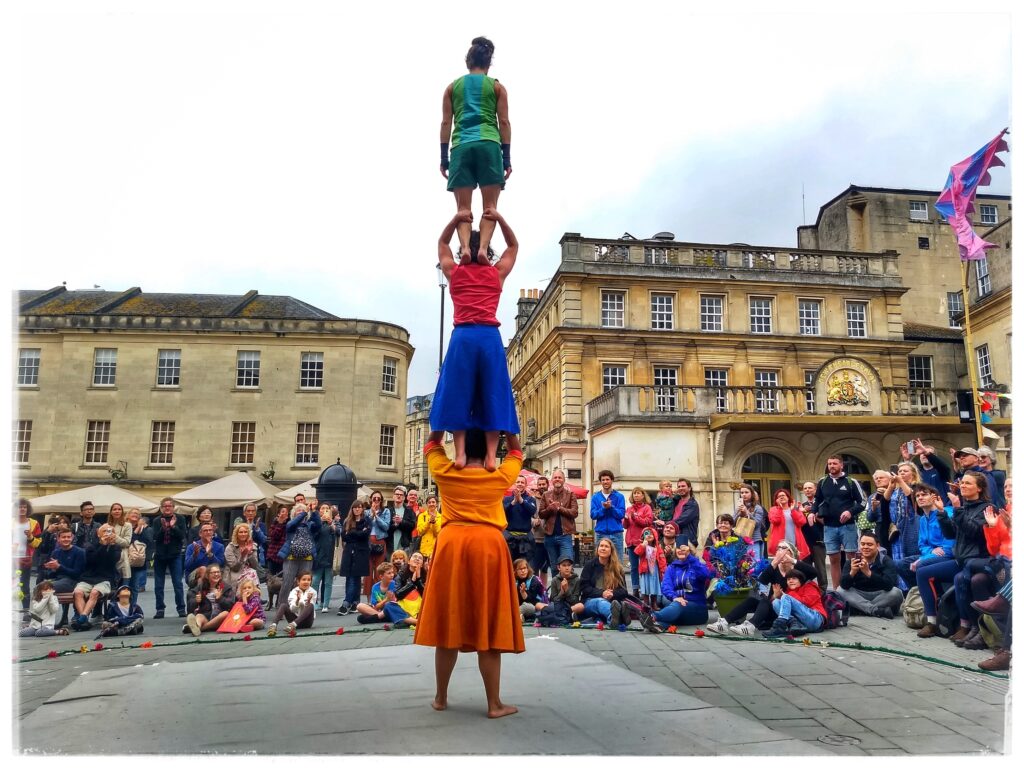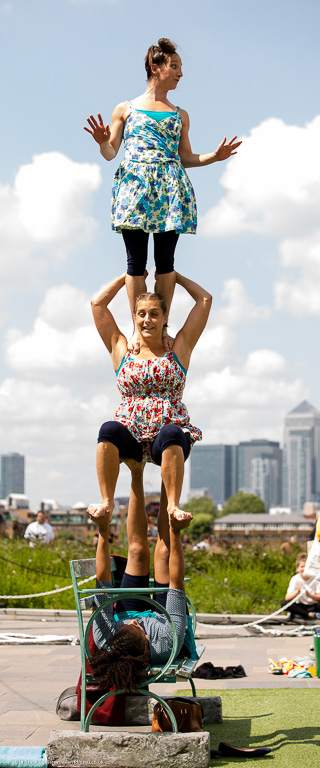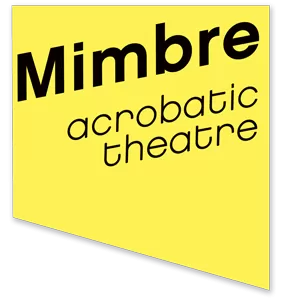
21 Apr Our approach to: Working with high physicality outdoors
Working with high physicality outdoors: challenges and solutions by Lina Johansson, Mimbre acrobats.
Since everyone is currently talking about outdoor theatre, we thought it worth sharing Lina Johansson’s talk at the recent online European Federation for Education and Training in Street Arts online conference in Slovenia more widely. Here Lina outlines some of the challenges specific to performing with highly physical skills outdoors, as well as sharing strategies and tips that Mimbre has developed to mitigate against them.
This article appears on Without Walls TALKS.

At Mimbre we love the outdoor theatre setting and audiences, and have used acrobatics, acrobalance (partner acrobatics) and movement to create outdoor theatre shows for over 20 years, touring festivals and events across Europe and worldwide. But as highly physical performers reliant on our bodies for our art, touring outdoors comes with a whole lot of challenges which are important to acknowledge to be able to mitigate against. The thrill and visual impact of demanding physical skills, such as acrobatics and acrobalance, is a great way to create interest, visibility and connection with street theatre audiences. However, the constantly changing conditions of outdoor settings can also throw up many challenges in regards to keeping the performers safe.
I’d like to share some of the challenges we have found working outdoors, along with the artistic and logistical solutions we have developed to mitigate them, keeping our performers safe, while still trying to push our skill level and wow our audiences to the max.
Most of our performers are from a circus training background, but I think most tips are applicable to any work with intense physical skills for outdoor performance, be it circus, dance, physical theatre, clowning, tricking, parkour and so on.
We want to share these examples with other performers and companies of course, but also as importantly, with producers and event organisers, so they can bear these things in mind in their planning. Each challenge might seem minor, but together they add up to exert a lot of stress on the performers’ bodies and any areas you can give support will help to make a difference.
As a sector it is of utmost importance that we work together to look after the health and longevity of our performers. Well looked after performers make for great shows and happy audiences. Broken performers or no performers means there is… nothing. So looking after them is not just a kind gesture, it’s a necessity for us all!

What are the challenges?
Some examples of outdoor challenges (this list is by no means exhaustive…):
Surface
+ a lot of science has been put into the creation of sprung dance floors for theatres and dance studios, acknowledging the importance of a firm surface that still has some give for landing and take-offs… In an outdoor setting, you instead have concrete, gravel, grass, or the worst of them all for feet and ankles, cobblestones.
The real world is never flat!
+ we always ask for a flat area for our performance site, but the fact is that outdoors no area is ever perfectly flat. There is always an incline. It’s an incline you don’t notice if you just look at it or walk through it, but when you are balancing two other bodies on top of your shoulders you do feel it.
Weather
+ when you tour outdoors, the first thing to be aware of is the risk of rain and the impact on your bodies, surfaces and set. But you also need awareness of how you might deal with strong wind, extreme heat (causing heat fatigue, sun stroke and rivers of sweat), sun in the eyes, humidity and how any of this might influence the safety of the performers and the viability of the choreographies.
The world is your stage – with small children, dogs and footballs entering at will…
+ outdoor performances are full of surprises and while that is part of the charm we need to bear them in mind when we stage very physical shows. Small children regularly get inspired by Mimbre’s acrobats and want to join in mid-show to show off their forward rolls (even if that’s just under the acrobats’ feet). Dogs want to chase props. And random footballs from a nearby street game have arrived over the heads of the audiences to land on ‘our’ stage mid-choreography. I even had a beer can dropping from the skies above me once.
Tight schedule and constant visibility
+ your performance area is most of the time shared with other performers, with a tight changeover time between shows. If it starts raining you might have to reschedule your show times. If there are delays to the groups in front of you, those have a knock-on effect to your start time, often with very short notice. Your stand-by pre-show tension can go on for a long time. You often have to do any set changes with an audience already waiting and you have to find ways of finding your pre-show focus even if an audience is staring at you in your often very exposed ‘backstage’ area.

Touring and travelling – impact on body
+ while this is not specific to outdoor performance, I thought it still worth mentioning as an important element to bear in mind as performers and tour bookers. A long journey in a van or car makes everyone feel less than great in their bodies and mind, and the idea of going straight from a five hours drive to start doing backflips makes me exhausted just thinking about it. And after two days in a van I normally feel like I will never walk again, my head literally spins and it feels like the ground is moving. For overseas gigs add jet-lag into the mix…
These are some concrete examples of challenges, which might make you wonder why anyone would ever put on a highly physical show on the street. But trust me – there are so many other things about outdoor performances and touring that make it all worth it!
Just plan in strategies to mitigate against everything I’ve talked about from the start of your creation. This will protect your company and your performers and you can have years of fun, amazing, rewarding, exciting, incredible performances and touring ahead of you. Here are some of ours:
What are our tips and strategies?
Make sure you have time for a thorough warm-up and rehearse your main tricks on the performance site
+ we have found that a dedicated, focused time for warm-up and rehearsals on site is crucial to create resilience for quite a few of the above mentioned challenges.
+ for each show we develop a schedule of how long we need and approximately when it needs to take place in relation to the show time – taking into account the main physical demands for the show, what the performers’ individual needs are, if we have a big set to build and how long the performers need to get into costume and make-up, while also making sure that eating fits into that schedule somewhere!
Dedicated warm-up space
+ having a focused, dedicated space for warm-up is so helpful. Yes, when the weather is just right we love warming up in the park, but if it’s raining then we suddenly don’t have a space to warm-up properly (when we most need it!) and if it’s really hot then you get fatigued before the show. Also, warming up publicly often attracts attention from bystanders who sometimes want to discuss your whole training regime in detail (this seems especially true if you are a woman), despite you being tight with time. Programmers, please dedicate a suitable space for your physical performers when planning your backstage area and changing rooms. It can be a room, a tent or the performance space cordoned off when not in use. Having that focused, dedicated space to get your body properly warmed up and ready makes it easier to deal with the rest of the surprises and distractions of the outdoors.
Rehearse the big tricks on the performance site.
+ having a moment to run through your main tricks in the performance space gives you a chance to address several of the above mentioned challenges. For example – during the acrobatic pyramids, if there is a significant lean we might rotate the position of the trick to a position where the performers can best adjust for it (for example we often find it easier to adjust to the lean if it’s going from front to back, rather than sideways through the balance). If the lean is just too much for a trick to be safe, then we have time to work out an alternative and the impact it will have on any other part of the choreographies.
+ this also applies to things like sun in the eyes or a strong wind. It gives a chance to adjust and make your body familiar to the surface, to its potholes and unevennes, and to work out your exact use of the space, finding the firmest flattest bit for your main tricks.
+by having some time in the space before the performance we can address a whole lot of challenges with time to solve them. If later on the schedule gets rushed or times get changed, it also makes a big difference mentally to go into a performance space that you have already orientated yourself in and to find and keep your focus.

Creating with flexibility and with the outdoor in mind
+ when creating a show for the outdoor, build in options to adapt and change tricks and choreographies within the structure of the show when circumstances are challenging. For example, in Lifted we do a three-high pyramid (three acrobats standing on top of each others’ shoulders creating a 5m+ metre tall column). We were aware that if circumstances were harsh, this would not be a safe trick to do, so we created an alternative ending, with a shape that did not go as high and where the base felt she had more ability to adjust.
+ we have a trick that is just called ‘the reserve’, a back-up trick that we know we can always do safely, so it can replace other harder tricks if there is a problem, without messing up the flow or the timing of a choreography.
+ in general we always try to train to have more tricks under our belt than what we put in our show, and to work with performers who are creative and adaptable – not only the ones with the highest skill set. Also, don’t squeeze a trick in if it’s not solid and ready. The performers having to worry about the safety of a trick will distract them from being fully present and from enjoying performing. Also, with the unpredictability in what might come at you, there needs to be some resilience to deal with surprises.
+ we also make it clear that it is in the power of any of the performers to call a trick off if they don’t feel safe, and then to work out an alternative as a group. This applies even if it is in the middle of a show and something unexpected happens (dog, wind, child, football or slippery surfaces). I think empowering everyone to hold responsibility and decision-making power creates a heightened awareness between the performers to check in with each other and to adapt on the go, not blindly follow a choreography. Or if necessary, to call a stop, for example if rain makes it too slippery, and to ask the audience to come back for a later performance, rather than pushing through to the risk of an accident happening.
+ rehearse outdoors. Once you’ve got the tricks safe, train them in a park a few times, to get used to different surfaces, sun in the eyes and distractions around you. Similarly, once the choreographies are set, if there is a safe space you can run them outside give it a go, however awkward that might feel when there isn’t an actual festival on. Passers-by will still love you!
Build mats or suitable floor adjustment into the set design
+ when creating the set and the choregraphies, bear various floor surface scenarios for the tour in mind and the immediate risk or long-term effect they might cause. We always build some form of mats into our set-design. It serves two purposes: to protect the performers if something unexpected happens and they fall from a trick, but it also protects their ankles and knees from the long-term impact from landing on hard surfaces.
+ also consider how landings can be softened or caught by the other performers (for example using a somersault to catch rather than landing on the floor). Consider shoes that might cushion working on hard ground.
+ when choosing mats, consider how slippery they might get when wet (we normally cover ours with a carpet) and how hot they might get if the sun shines on them (the colour of the mats makes a big difference!)
Other bits and pieces:
+ to deal with sweat and humidity, create moments in the show where the performers can put chalk or rosin on their hands.
+ if there is a risk of the floor area getting hot, look into how the performers could adjust it, or if they can have shoes to perform in.
+ think of the possible problems ahead so you can find solutions when you have the time to think creatively about them! Allow flexibility to adapt, change and grow the show as it starts its tour.
What about tour scheduling?
Travel days
+ if a gig is more than two and a half hours away, we ask the programmers to provide accommodation so we can either travel out the day before or go home the day after (give or take depending on how much set-up we need, if it’s one or two shows, the times and so on). In general, we find that more than three hours in a van on the same day as getting ready for a physical show is detrimental.
+ a couple of years ago we also worked with a gyrokinesis teacher to develop a small spine release sequence, that each performer can do individually either during or at the end of a long day of travelling. And if we do a long haul two day drive across Europe, we try to do the longest stretch on the first day if possible, to arrive in time for a walk and some fresh air on the second day.

Training sessions in-between gigs
+ we try to book in regular training sessions for the team in between performance dates, especially if there has been a longer break between gigs. This is to be able to train the tricks to keep familiarity between the performers’ bodies and to make sure the tricks are solid and safe. Also this allows for a space to address any technical issues there have been around the tricks on tour, without the stress of another performance coming up in the next hour.
Communication and contracting
+ be really clear to the event organiser about your needs, with some flexibility and without being unreasonable.
+ we have now added a heat clause to our contracts as well as a rain clause (basically we will always try to perform or finish a performance, but if rain or extreme heat makes it unsafe, we want to make sure we will still be paid for having been there on stand-by and ready to go, unless the organiser can provide an alternative space).
+ we use our above mentioned schedule of warm-up, rehearsals and preparation time to give the event organiser an indicative idea of the earliest show time we can do. For example if they plan a 9am show for school children, but that means our performers have to start getting ready at 5am, that is not great if the show could just as well have taken place at midday.
+ we also normally put an indication on what the minimum recovery time is between performances, for the performers to have a chance to catch their breath and get something to eat before going on again.
+ we appreciate that the clearer we can be to the event organisers, the easier it is for them to support us. And if we are all able to listen, respect and be flexible around each others’ needs, the better the festival will be!
These are just some examples of our strategies, and I’m sure there are many others (please share yours with us). I hope some of it was useful and applicable to your work and whatever part of outdoor arts you are involved in – good luck and enjoy!


Sorry, the comment form is closed at this time.